Nov . 09, 2024 07:51 Back to list
Revitalize and Restore Your Vehicle's Brake Drums for Enhanced Performance and Safety
Resurfacing Brake Drums An Essential Maintenance Step for Vehicle Safety
Brake drums are crucial components in a vehicle's braking system, particularly in older cars and certain heavy-duty vehicles. They are parts of drum brakes, which utilize friction to slow down or stop the wheel's rotation. Over time, brake drums can become worn or damaged, leading to decreased braking efficiency and safety hazards. One effective way to restore their functionality is through resurfacing, a process that enhances the performance of brake drums and extends their lifespan.
Understanding the Resurfacing Process
Resurfacing brake drums involves machining the drum’s inner surface to create a smooth, even finish. This process is typically performed using a specialized lathe that removes a thin layer of material from the drum's surface, eliminating imperfections such as grooves, scuffs, or uneven wear that might have developed over time due to friction and heat.
Before the resurfacing begins, a technician will thoroughly inspect the brake drum for cracks or significant wear that could make resurfacing impractical or unsafe. If the drum is within the manufacturer's specified thickness and free from serious defects, it can be resurfaced. The ideal scenario for resurfacing is to remove just enough material to restore a uniform contact surface for the brake shoes, which are the components responsible for creating friction against the drum.
Signs That Brake Drums Need Resurfacing
There are several indicators that may suggest it’s time to consider resurfacing your brake drums
. These include1. Vibration During Braking If you feel a pulsating or vibrating sensation when applying the brakes, it could be due to warping or uneven wear in the brake drums. 2. Noise Unusual noises, such as grinding or squealing, may occur when the brake shoes make insufficient contact with the drum, often signaling that the drum surface is damaged. 3. Reduced Braking Performance If you notice that your vehicle takes longer to stop than usual or the brakes feel less responsive, resurfacing the drums may help restore performance.
resurface brake drums

4. Visual Inspection Regular inspections can reveal cracks, scoring, or significant wear on the drum surfaces that warrant resurfacing.
Benefits of Resurfacing Brake Drums
Resurfacing brake drums offers several advantages
- Improved Braking Performance A smooth and even surface enhances the friction between the brake shoes and the drum, providing more effective braking. - Cost-Effectiveness Resurfacing is usually less expensive than replacing the entire brake drum assembly. By resurfacing, you can save on costs while restoring your vehicle's safety features.
- Extended Lifespan Keeping brake drums in good condition through resurfacing can prolong their lifespan, preventing the need for premature replacements.
- Enhanced Safety Adequate braking performance is vital for the safety of any vehicle. Resurfacing helps ensure that drivers and passengers are safe on the road.
Conclusion
Resurfacing brake drums is an important step in vehicle maintenance that should not be overlooked. This process not only improves braking performance but also contributes to the overall safety and longevity of the braking system. Regular inspections of brake components, combined with timely resurfacing when necessary, can prevent more serious issues from occurring and keep your vehicle operating smoothly. If you suspect your brake drums may need attention, consult a qualified mechanic to assess the condition and decide on the most effective course of action. Remember, proper maintenance is key to a safe driving experience.
-
Liza Brake Drum: Superior Quality & Performance for Safe Driving
NewsAug.24,2025
-
Iveco Brake Drum | Premium OE Quality for Daily & Eurocargo
NewsAug.22,2025
-
Your Brake Drum Man: Quality & Performance Parts
NewsAug.21,2025
-
Explore Japan: Ultimate Travel Guide & Authentic Experiences
NewsAug.19,2025
-
Your Brake Drum Man: Premium & Reliable Brake Drums for Sale
NewsAug.18,2025
-
ROR Web Development: Build Fast, Scalable, Secure Apps
NewsAug.17,2025
